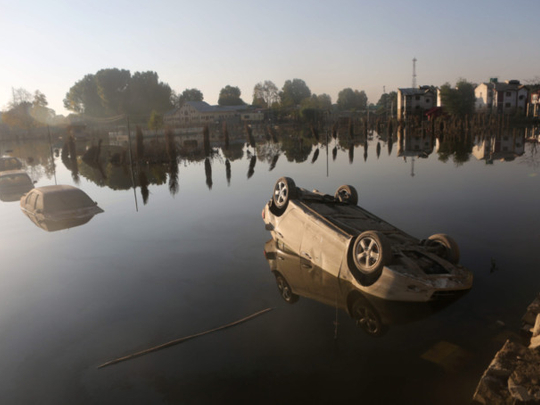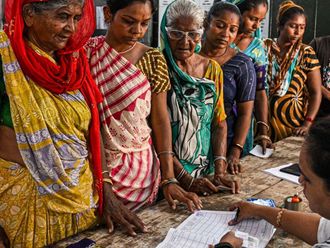
Earlier this month a devastating flood swept through the Indian state of Jammu and Kashmir. Described as the worst ever natural disaster to hit this politically unsettled region, the tsunami-like floods caused a death toll of over 550 with thousands left homeless and hundreds of millions of dollars in damages. The total magnitude of the horrendous destruction and the number of dead and missing may not be known for quite some time. The floods even swept neighbouring areas in Pakistan as well as the provinces of Punjab and Sindh.
Srinagar, the capital of Jammu and Kashmir was the hardest hit with the city almost completely submerged in the flooding, leaving more than a million residents paralysed from their normal daily activities. According to some reports, the Kashmir Valley was cut off from the rest of the world for days. Along with Srinagar, thousands of villages were also reported as being submerged. Hundreds of thousands of people, particularly in the rural areas, still remain trapped without any outside help or rescue and relief.
As a blow back in such cases, communication networks quickly disappeared leaving no means of contact between the stranded with their loved ones. The actual magnitude of the destruction, the number of dead and the people who are missing may not be known for some time. There were allegations that relief efforts were slow and the state government offered no immediate response to the calamity. Compounding the human misery was the evident the lack of boats, which forced people to linger on their rooftopsto avoid the ravaging floods as they waited for someone to rescue them.
According to a Reuters report on September 13, 2014, almost two weeks after the floods, “residents stranded for days by the floodwaters said that the Indian army has selectively evacuated tourists and people according to a preset priority list, leaving locals to be rescued later by volunteers”. Such charges enraged a population whose struggle for their own identity has been well recorded historically. Even the state government came under heavy criticism for its apparent failure to address the calamity in a rapid manner.
Dr Gulam Nabi Fai, Secretary General of the World Kashmiri Awareness, charged that “The state government has collapsed all together. They seem to have no control over the situation. Although the flood control department in Kashmir had predicted in 2010 that such a disaster was possible and they had reported it to the government of India, no action was taken. Why not? That’s the question which everyone is asking. Was it because of the deforestation, the centuries old melting of glaciers, or due to the recklessness of the trekkers [tourists]? These are the questions that need to be answered.”
Sunita Narain, an environmental activist based in Delhi also faults the state government for gross negligence and not having the foresight to predict that such a disaster was in the offing. “Kashmir’s unusually high rainfall was only part of the problem. The state does not have a flood forecasting system or capacity for disaster preparedness. Most of the natural drainage channels have been destroyed due to utter mismanagement. The traditional system of flood management was to channel the water from the Himalayas into lakes and water channels. But over time, we have forgotten the art of drainage — we only see land for building, nothing for water. It is time we read the writing on the wall.”
But such a seemingly tepid relief response from both the authorities did not deter the thousands of Kashmiri youth who came to the rescue of the stranded and the homeless. Braving conditions that were perilous to their own lives, these young Kashmiris transcended all barriers of religion and caste as they rendered assistance to Muslims, Hindus and others caught in the middle of the disaster. They were not selective about saving lives. Nor did they politicise their brave efforts. They stepped up for the cause of humanity.
Even beyond their borders, the selflessness and commitment of these Kashmiri youth to give a helping hand to folks back home was evident. In the United States and elsewhere, youth of Kashmiri heritage had taken on the extraordinary task of initiating relief and disaster activity as well with very little global media coverage or awareness. As Dr. Fai says, “They did it irrespective of their ideological preferences or cultural affiliations or regional backgrounds. They do have limited resources, but their eagerness to work has proved to be exemplary. They are a few hundred dedicated group of volunteers from all over the world. Their dedication and selflessness need to be highlighted. They have a clear objective. They are trying to establish relief camps and shelters, provide life saving medicines, clean water, food and clothes to the needy.”
In a further denouncement of government relief efforts, Anuradha Bhasin Jamwal, a journalist and peace activist based in Jammu and Kashmir who has been extensively covering the Kashmir conflict said, “This is time to sink ideologies and prejudices and not allow them to prevail over humanity.” Without having been told to, the Muslim youth of Kashmir are doing just that. Bravo to them and like-minded people everywhere.
Tariq A. Al Maeena is a Saudi socio-political commentator. He lives in Jeddah, Saudi Arabia.









